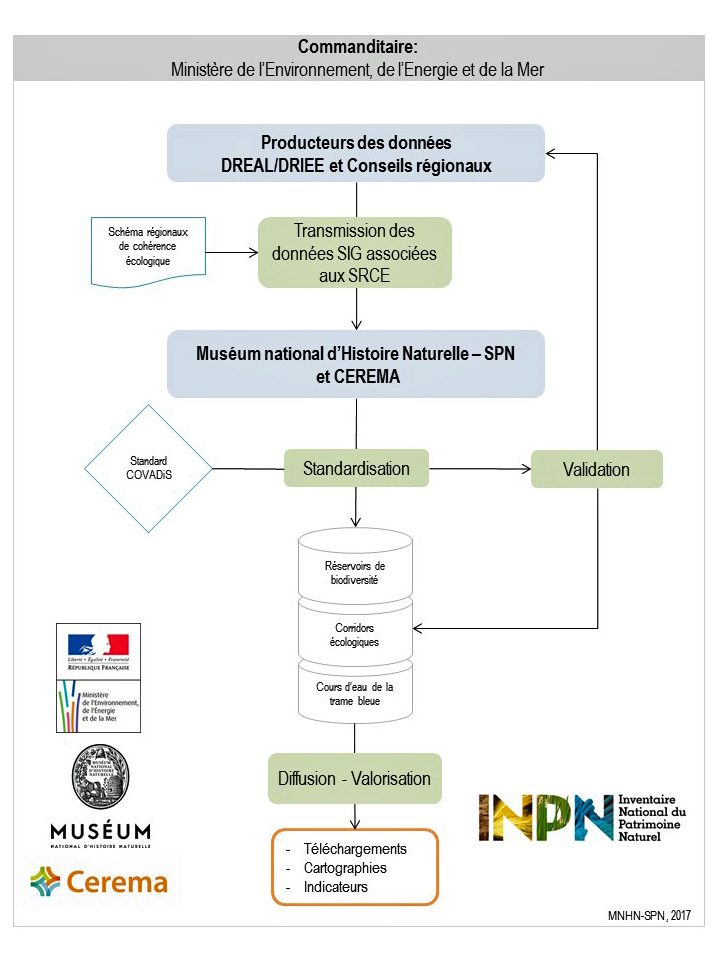
The Regional ecological-continuity plans (SRCE) are planning documents that implement TVB policy on the regional level. They are prepared jointly by the Regional environmental directorates and by the Regional councils. The SRCE approval phase took place from 2013 to 2015 and Picardie was the only region not to succeed in having the document formally adopted by the Regional council. In Corsica, the Sustainable-development and management plan (PADDUC) and, in the overseas territories, the Regional planning documents (SAR) are considered the equivalent of the SRCEs(art. L371-4 in the Environmental code).
SRCEs comprise several parts (art. L371-3 and R371-25 in the Environmental code) :
The atlas must contain several types of maps including (art. R371-29 du code de l’environnement) :
A standardised data format was established and validated by the Commission for validation of spatial-information data (COVADIS) for the geographic data provided with the SRCE atlases. However, it was published in May 2014, after the approval of the ON-TVB guidelines four months earlier. That is why the ON-TVB guidelines stipulated that SRCE data comply with the data models supplied by the ministry, but did not specifically mention the COVADIS standard.
The COVADIS SRCE V1.0 standard comprises five data classes, namely cores, corridors, watercourses, obstacles and priority projects. Each class includes descriptive data on, for example, the national and regional subnetworks or the objectives in terms of preservation and restoration. The standard was designed such that the values attributed by the regions could be preserved.
More information on the COVADIS SRCE standard
The Ecology ministry assigned to the Museum, as a major participant in the TVB resource centre, the task of centralising, standardising and disseminating SRCE data throughout France.
The objective is to facilitate the availability of the SRCE data for diverse users by providing homogeneous, national datasets that can be directly downloaded. A particular objective was to meet the needs of various partners for data on the inter-regional and national levels. The application also includes a retrieval system for large-scale data in map form. However, the legally binding maps in the SRCEs are those provided by the Regional environmental directorates and the Regional councils.
The procedure in setting up the national database, managed by the MNHN, took place in four steps (see the diagram below):
1 - The SRCE data was retrieved from the regions and analysed to determine the degree of conformity with the COVADIS standard,
2 - The data were standardised by the MNHN and Cerema,
3 - The standardised data were sent back to the regions to be validated,
4 - Once validated, the data could be disseminated.

Figure 4 : Constitution of the national database for the TVB programme (© UMS PatriNat)
The work dealt with the cores, corridors and watercourses classes. The data on obstacles and priority projects were not processed for this particular mission.
Data standardisation consisted of modifications in the fields of the attribute tables and in table combinations, however an effort was made to alter the data produced by the regions as little as possible. The geographic data was not modified.
More information on the standardisation procedure
The Museum worked with the National geographic and forestry institute (IGN) to produce a national SRCE map using the standardised data. This work led to a national map of the biodiversity cores and the corridors , using generalisation methods.
Note to readers
Validity of the available data
The standardised data made available by the MNHN are not legally binding and serve strictly for informational purposes. The legally valid document is the SRCE approved by the regional Prefect and the President of the regional council. More precisely, the atlas in the SRCE is the legally binding document concerning the geographic parameters of the components in ecological networks. It should be noted that the symbols used by regions in mapping their networks and the format of the data used for the maps (in geographic information systems (GIS)) do not necessarily coincide.
Contents of the national database
The atlases of some SRCEs indicate additional elements of ecological networks, for example permeable areas. These elements are included in the regional databases. Note however that there are no provisions in the COVADIS SRCE standard to store these elements. Inclusion of these elements in the national database would have introduced excessive heterogeneity in that the additional elements do not exist in all SRCEs. For these reasons, the national database contains only the cores, corridors and watercourses (note that the latter are both cores and corridors, but for data-processing purposes were handled separately in the COVADIS standard. To access the data that may be found in the atlases of certain SRCEs, it is necessary to consult the given SRCE.
Télécharger la couche nationale des réservoirs de biodiversité
Télécharger la couche nationale des corridors
Télécharger la couche nationale des cours d’eau
Télécharger la couche nationale des réservoirs, corridors et cours d’eau
Dictionnaire de données (manuel de lecture de la base de données)